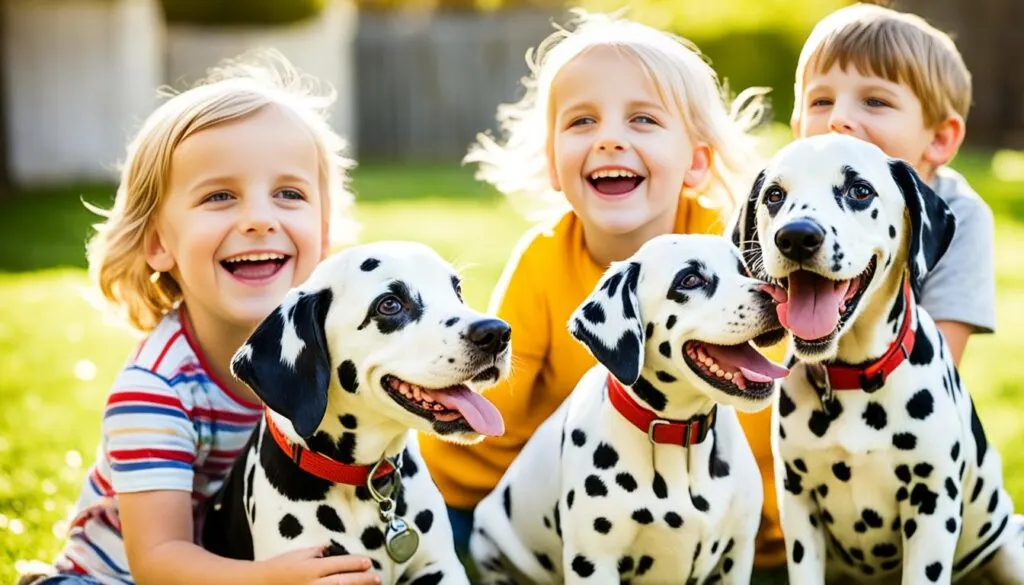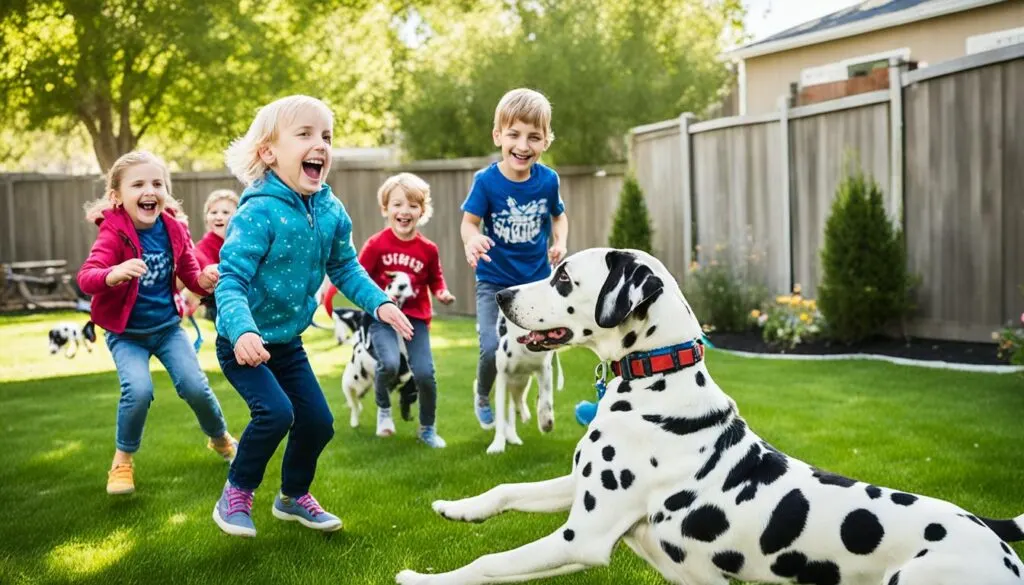Did you know that Dalmatians have been popularized as family pets for decades, thanks to their iconic spots and friendly reputation?
However, before considering a Dalmatian as a pet for your household with children, it is important to delve deeper into their temperament, upbringing, and socialization.
These factors play a crucial role in determining their behavior around kids, ensuring a harmonious and safe environment for both the dog and the children.

Click Here to Jump to a Section
Key Takeaways:
- Dalmatians can be good family pets, but their temperament and behavior around kids can vary.
- Understanding a Dalmatian’s breed-specific traits and individual temperament is essential before bringing them into a home with children.
- Early socialization and positive interactions with kids are important for fostering a positive relationship between a Dalmatian and children.
- Setting realistic expectations, involving children in dog care responsibilities, and ensuring ongoing training and discipline contribute to a successful and safe family dynamic.
- Assessing the compatibility of a Dalmatian’s energy levels with your family’s pace is crucial for a harmonious match.
Understanding the Dalmatian’s Temperament
Dalmatians have a wide range of temperaments, which can vary from dog to dog.
While some Dalmatians may be naturally gentle and patient, others may have a more intense or excitable temperament.
Wide Range in Temperament Amongst Dalmatians
The temperament of Dalmatians can differ significantly from one dog to another.
It’s important to keep in mind that not all Dalmatians have the same disposition when it comes to interacting with children.
The Importance of Breeding for Temperament
The breeding of a Dalmatian plays a significant role in the development of their temperament.
Responsible breeders strive to produce dogs with stable and friendly personalities, ensuring that they can be suitable companions for families with children.
Socialization and Training as Key Factors
Socialization and training are essential in shaping a Dalmatian’s behavior around kids.
Early experiences and positive interactions can help them develop appropriate responses and manners, enabling them to be well-behaved and gentle with children.
Are Dalmatians Good with Kids?
Dalmatians have the potential to be good family pets and can get along well with kids.
However, it is important to consider factors like individual temperament, socialization, training, and the specific needs of the children in the household.
Some Dalmatians may naturally be more tolerant and patient with kids, while others may require more careful handling and guidance.
Assessing the specific dog’s behavior and compatibility with children is essential before bringing a Dalmatian into a household with kids.
The Role of Early Socialization
Early socialization plays a crucial role in shaping the temperament of Dalmatians around kids.
It helps them become familiar with different situations and builds their confidence when interacting with children.
Socializing Dalmatians at a young age provides them with positive experiences and teaches them appropriate behavior around kids.
Puppy and Child Interaction Techniques
Supervised play sessions and gentle handling are important techniques when it comes to the interaction between Dalmatian puppies and children.
Ensuring a calm and controlled environment allows both the puppy and child to engage in safe and enjoyable interactions.
Teaching children to be gentle and respectful towards the puppy helps foster a harmonious bond between them.
Ensuring Continued Exposure to Children
Continued exposure to children throughout a Dalmatian’s life is critical to maintaining their comfort and adaptability around kids.
Regular interactions with children help reinforce positive associations and reinforce appropriate behavior.
Whether it’s through visits to parks, playdates with friends, or supervised encounters with children in the neighborhood, exposing Dalmatians to different child-friendly environments helps them develop into well-rounded family pets.
Bringing a Dalmatian into a Family with Kids

When considering adding a Dalmatian to your family with kids, it is crucial to set realistic expectations and ensure that everyone is prepared for the responsibilities and challenges that come with owning a dog.
While Dalmatians have the potential to be great family pets, it is essential to understand their temperament and suitability for children.
Setting Realistic Expectations
Before bringing a Dalmatian into your family, it is important to have a clear understanding of the breed’s characteristics and behavior around children.
Dalmatians are known for their energetic nature and require sufficient exercise and mental stimulation.
It is essential to assess if your family’s lifestyle and energy levels align with the needs of a Dalmatian.
Involving Children in Dog Care Responsibilities
Involving children in the care of a Dalmatian can be an excellent way to foster a sense of responsibility and create a strong bond between the child and the dog.
Assign age-appropriate tasks such as feeding, grooming, and training, under adult supervision.
This not only helps teach children about responsibility but also builds trust and respect between them and the Dalmatian.
Open communication and education about dog behavior and safety are vital to create a positive and safe environment for both the dog and the children.
Teach children how to approach and interact with the Dalmatian in a respectful and gentle manner.
Emphasize the importance of never disturbing the dog while it is eating or sleeping and avoiding rough or aggressive play.
By involving children in the care of a Dalmatian and educating them about responsible pet ownership, you can create a harmonious and loving relationship between your family, children, and the Dalmatian.
Potential Challenges with Dalmatians and Young Children
While Dalmatians can be great family pets, there may be potential challenges when it comes to their energy levels and size.
Dalmatians are known for their high energy and need for regular exercise, which may require active involvement from the entire family, including young children.
Managing the Energy and Size of a Dalmatian
Dalmatians are an active breed that requires plenty of physical exercise to keep them happy and healthy.
This can include daily walks, jogging, or engaging in active playtime. It’s important to provide outlets for their energy to prevent them from becoming bored or developing destructive behaviors.
When living with young children, it’s crucial to ensure that the Dalmatian’s exercise needs are met, as their high energy levels may pose a challenge for busy households.
Active involvement from all family members can help provide the necessary exercise and mental stimulation for Dalmatians, which can positively impact their behavior around children.
Understanding a Dalmatian’s Strength
Another potential challenge when living with young children is managing a Dalmatian’s strength.
Due to their size and muscular build, accidental knocks or rough play can potentially harm young children.
It’s important for children to understand how to interact respectfully and gently with the dog to ensure their safety.
Setting appropriate boundaries and rules can help prevent accidents and ensure a safe and enjoyable interaction between kids and Dalmatians.
Teaching children to be aware of the dog’s physical capabilities and how to handle them with care is essential.
It’s also important for adults to supervise interactions between young children and Dalmatians to ensure everyone’s safety.
Adapting an Adopted Dalmatian to Your Home

When adopting a Dalmatian, it is important to take steps to ensure a smooth transition and integration into a home with kids.
Introducing new pets to kids and teaching children how to interact respectfully with dogs is crucial for building trust and establishing a positive relationship.
Introducing New Pets to Kids and Vice Versa
Introducing a new Dalmatian to children should be done gradually and under supervision.
Start by allowing the dog and children to become familiar with each other’s scents.
Then, slowly introduce them in a controlled environment, providing positive reinforcement and rewards for calm and gentle behavior from both parties.
Remember to prioritize safety and monitor interactions closely, allowing both the dog and children to adjust at their own pace.
Slowly increasing the amount of time they spend together can help foster a comfortable and trusting relationship.
Teaching Kids Respectful Interaction with Dogs
It is essential to teach children how to interact with dogs in a respectful and appropriate manner.
Emphasize the importance of gentle handling, avoiding rough play, and never disturbing a Dalmatian while resting or eating.
Teach children to recognize and respect a dog’s boundaries and signals, such as growling or avoiding eye contact.
Incorporate positive reinforcement techniques to reward children for treating the Dalmatian with kindness and respect.
Encourage them to engage in activities that promote bonding and trust, such as gentle petting, supervised play sessions, and participating in the dog’s care routines.
By educating children about responsible pet ownership and fostering respectful interactions, you can ensure a harmonious and safe environment for both your Dalmatian and your family.
Prepping Your Dalmatian for a New Baby in the Family
Establishing a Positive Introduction Environment
Bringing a new baby into a home with a Dalmatian requires careful preparation and consideration.
It is essential to create a positive introduction environment for both the dog and the baby.
One way to do this is by allowing the dog to become familiar with the baby’s scent before the actual introduction.
You can bring home an item of clothing or a blanket with the baby’s scent on it and let the dog sniff it.
This helps the dog associate the scent with something positive and builds familiarity.
Gradual introductions are also crucial.
Start by allowing the dog to observe the baby from a safe distance and gradually decrease the space between them over time.
Always supervise their interactions closely to ensure the dog remains calm and gentle.
Reward the dog with treats and praise for calm behavior around the baby, reinforcing positive associations between the two.
Safety Measures When Introducing a Dalmatian to a Newborn
When introducing a Dalmatian to a newborn, it’s important to prioritize safety.
Create a safe space for the baby where the dog cannot reach, such as a crib or playpen.
This provides a barrier and a designated area for the baby to be protected while getting acclimated to the presence of the dog.
Always monitor the dog’s behavior closely during interactions with the baby.
Pay attention to body language and signs of discomfort or stress, such as stiff posture, growling, or bared teeth.
If you notice any concerning behavior, separate the dog from the baby and seek guidance from a professional dog trainer or behaviorist.
It is also crucial to teach the baby about respectful interaction with the dog.
Even at a young age, babies can learn not to pull the dog’s ears or tail and to be gentle when touching.
This helps establish boundaries and fosters a safe and harmonious relationship between the baby and the Dalmatian.
Ensuring Your Dalmatian is a Family-Friendly Pet
To ensure that a Dalmatian remains a family-friendly pet, consistent training and discipline are essential.
Reinforcing commands, teaching appropriate behavior, and setting boundaries help establish a well-behaved dog that is safe and enjoyable to be around children.
Consistent Training and Discipline
Consistent training is crucial for shaping a Dalmatian’s behavior around kids.
Start training your Dalmatian from a young age and use positive reinforcement techniques such as treats, praise, and rewards.
Teach them basic commands like sit, stay, and come, as well as important manners like not jumping on people or stealing food.
Establish consistent rules and boundaries for your Dalmatian and ensure that all family members are consistent in enforcing them.
This will help your Dalmatian understand their place in the family and what behavior is expected of them.
Be Aware of the Dog’s Health and Wellbeing
Maintaining your Dalmatian’s health and wellbeing is crucial for their temperament and compatibility with kids.
Schedule regular vet check-ups to ensure that they are up to date on vaccinations and are free from any health issues.
Provide a balanced diet that meets their nutritional needs and ensure they have regular exercise to burn off excess energy.
A tired Dalmatian is less likely to engage in destructive behavior or become hyperactive around children.
Regular grooming sessions, such as brushing their coat and trimming their nails, not only contribute to their physical wellbeing but also help your Dalmatian feel more comfortable and relaxed around the family.
Dalmatian’s Suitability for Children and Family Dynamics

When considering a Dalmatian as a family pet, it is crucial to evaluate your family’s lifestyle and dynamics to determine if this breed is well-suited for your household.
Assessing various factors can help you make an informed decision and ensure a harmonious match between your family and a Dalmatian.
Evaluating Your Family’s Lifestyle
Take into account the activity levels within your family.
Dalmatians are energetic dogs that require ample exercise and mental stimulation to thrive.
If your family leads an active lifestyle with plenty of outdoor activities, a Dalmatian may be a great fit.
However, if your family prefers a more relaxed pace and cannot commit to providing the necessary exercise, this breed may not be the most suitable choice.
Matching the Dog’s Energy with Your Family’s Pace
Consider the compatibility of a Dalmatian’s energy with your family’s daily routine.
These dogs have a high energy level and require regular physical and mental stimulation to prevent boredom and undesirable behavior.
If your family has the time and commitment to engage in vigorous play sessions, walks, and training exercises, a Dalmatian can thrive and become a beloved member of the family.
However, if your family has limited time for exercise and cannot provide the necessary outlets for a Dalmatian’s energy, it may be advisable to explore other breeds that have lower activity requirements.
Remember, each family is unique, and while Dalmatians can be excellent family pets, it is important to evaluate your family’s lifestyle and dynamics to ensure a successful and fulfilling partnership with a Dalmatian.
By considering the activity levels and the compatibility of the dog’s energy with your family’s pace, you can make an informed decision about whether or not a Dalmatian is the right fit for your family and children.
